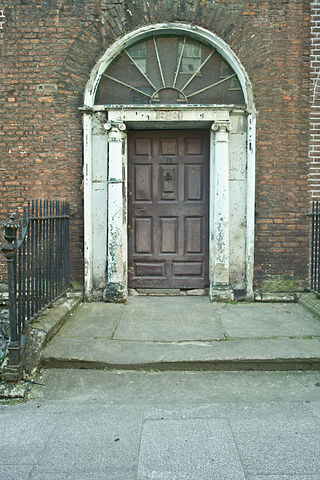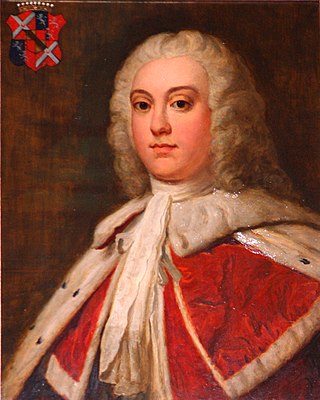Related Research Articles

Duke of Atholl, named after Atholl in Scotland, is a title in the Peerage of Scotland held by the head of Clan Murray. It was created by Queen Anne in 1703 for John Murray, 2nd Marquess of Atholl, with a special remainder to the heir male of his father, the 1st Marquess.
The Peerage of the United Kingdom is one of the five Peerages in the United Kingdom. It comprises most peerages created in the United Kingdom of Great Britain and Ireland after the Acts of Union in 1801, when it replaced the Peerage of Great Britain. New peers continued to be created in the Peerage of Ireland until 1898

Marquess of the County of Bute, shortened in general usage to Marquess of Bute, is a title in the Peerage of Great Britain. It was created in 1796 for John Stuart, 4th Earl of Bute.

Marquess of Waterford is a title in the Peerage of Ireland and the premier marquessate in that peerage. It was created in 1789 for the Anglo-Irish politician George Beresford, 2nd Earl of Tyrone. The title is presently held by Henry Beresford, 9th Marquess of Waterford.

Marquess of Downshire is a title in the Peerage of Ireland. It was created in 1789 for Wills Hill, 1st Earl of Hillsborough, a former Secretary of State.

Earl of Plymouth is a title that has been created three times: twice in the Peerage of England and once in the Peerage of the United Kingdom.
The title of Earl of Blessington was created twice in the Peerage of Ireland, in 1745 and 1816. Both creations became extinct, in 1769 and 1829 respectively. The earldom was also spelt as Blesington.
Viscount Windsor is a title that has been created twice.
The titles of Baron Mountjoy and Viscount Mountjoy have been created several times for members of various families, including the Blounts and their descendants and the Stewarts of Ramelton and their descendants.

John Stuart, 1st Marquess of Bute PC, FRS, styled Lord Mount Stuart until 1792 and known as The Earl of Bute between 1792 and 1794, was a British nobleman, coalfield owner, diplomat and politician who sat in the House of Commons from 1766 to 1776.
Gentleman of the Bedchamber was a title in the Royal Household of the Kingdom of England from the 11th century, later used also in the Kingdom of Great Britain. A Lord of the Bedchamber was a courtier in the Royal Household; the term being first used in 1718. The duties of the Lords and Gentlemen of the Bedchamber originally consisted of assisting the monarch with dressing, waiting on him when he ate, guarding access to his bedchamber and closet and providing companionship. Such functions became less important over time, but provided proximity to the monarch; the holders were thus trusted confidants and often extremely powerful. The offices were in the gift of The Crown and were originally sworn by Royal Warrant directed to the Lord Chamberlain.
Events from the year 1683 in Ireland.
Charles Gardiner was an Irish landowner and politician.

Luke Gardiner, 1st Viscount Mountjoy PC (Ire) was an Irish landowner and politician.

Lieutenant General William Neville Gardiner was an Anglo-Irish army officer, diplomat, and politician. During a career that spanned the 1760s to 1800s, Gardiner was involved in major historical events including the American Revolution, Partitions of Poland, and unification of Great Britain and Ireland. During the American Revolution he served on the staff of Sir William Howe and later commanded a regiment of his own. In 1792 he was appointed Minister Plenipotentiary to Poland and served in that role until the breakup of the country in 1795. Gardiner returned to Ireland in 1798 and in 1800 sat in the last Parliament of Ireland before the creation of the United Kingdom of Great Britain and Ireland. His final appointment came in 1805 when he was made the commander-in-chief of the British forces in Nova Scotia and New Brunswick. Gardiner held this position only briefly and died in Nova Scotia in 1806.

William Stewart, 1st Earl of Blessington was an Anglo-Irish peer and member of the House of Lords, styled The Honourable William Stewart until 1728 and known as The Viscount Mountjoy from 1728 to 1745.

William Stewart, 1st Viscount Mountjoy (1653–1692), was an Anglo-Irish soldier.

Herbert Windsor, 2nd Viscount Windsor, styled The Honourable Herbert Windsor until 1738, was a British landowner and Tory politician who sat in the House of Commons from 1734 until 1738 when he succeeded to the peerage as Baron Mountjoy and Viscount Windsor.
Blessington is a town located in County Wicklow, Ireland. Blessington may also refer to:

The Stewart baronetcy, of Ramelton in the County of Donegal, was created in the Baronetage of Ireland on 2 May 1623 for the soldier William Stewart.
References
- 1 2 Chisholm, Hugh, ed. (1911). . Encyclopædia Britannica . Vol. 18 (11th ed.). Cambridge University Press. p. 941.